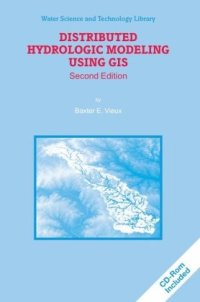
Ebook: Distributed Hydrologic Modeling Using GIS
Author: Baxter E. Vieux (auth.)
- Tags: Hydrogeology, Meteorology/Climatology, Waste Management/Waste Technology
- Series: Water Science and Technology Library 48
- Year: 2004
- Publisher: Springer Netherlands
- Edition: 2
- Language: English
- djvu
1. 5 REFERENCES 127 7 DIGITAL TERRAIN 129 1. 1 INTRODUCTION 129 1. 2 DRAINAGE NETWORK 130 1. 3 DEFINITION OF CHANNEL NETWORKS 135 1. 4 RESOLUTION DEPENDENT EFFECTS 138 1. 5 CONSTRAINING DRAINAGE DIRECTION 141 1. 6 SUMMARY 145 1. 7 REFERENCES 146 8 PRECIPITATION MEASUREMENT 149 1. 1 INTRODUCTION 149 1. 2 RAIN GAUGE ESTIMATION OF RAINFALL 151 ADAR STIMATION OF RECIPITATION 1. 3 R E P 155 1. 4 WSR-88D RADAR CHARACTERISTICS 167 1. 5 INPUT FOR HYDROLOGIC MODELING 172 1. 6 SUMMARY 174 1. 7 REFERENCES 175 9 FINITE ELEMENT MODELING 177 1. 1 INTRODUCTION 177 1. 2 MATHEMATICAL FORMULATION 182 1. 3 SUMMARY 194 1. 4 REFERENCES 195 10 DISTRIBUTED MODEL CALIBRATION 197 1. 1 INTRODUCTION 197 1. 2 CALIBRATION APPROACH 199 1. 3 DISTRIBUTED MODEL CALIBRATION 201 1. 4 AUTOMATIC CALIBRATION 208 1. 5 SUMMARY 214 1. 6 REFERENCES 214 11 DISTRIBUTED HYDROLOGIC MODELING 217 1. 1 INTRODUCTION 218 1. 2 CASE STUDIES 218 1. 3 SUMMARY 236 1. 4 REFERENCES 237 12 HYDROLOGIC ANALYSIS AND PREDICTION 239 1. 1 INTRODUCTION 239 x Distributed Hydrologic Modeling Using GIS 1. 2 VFLO™ EDITIONS 241 1. 3 VFLO™ FEATURES AND MODULES 242 1. 4 MODEL FEATURE SUMMARY 245 1. 5 VFLO™ REAL-TIME 256 1. 6 DATA REQUIREMENTS 258 1. 7 RELATIONSHIP TO OTHER MODELS 259 1. 8 SUMMARY 260 1.
This monograph sets forth a unified approach and principles for modeling hydrologic processes distributed in space and time using geographic information systems (GIS). The focus of this Second Edition is on the principles of how to implement a distributed model using geospatial data to simulate hydrologic processes. Once we embark on fully distributed representations of hydrologic processes, conservation laws form the basis for modeling, and spatial data management becomes necessary. A physics-based approach involves the laws that govern the complexities of all the paths that water travels, from precipitation falling over a river basin to the flow in the river. Worldwide geospatial data has become readily available in GIS format. A modeling approach that can utilize this data for hydrology offers many possibilities. GIS data formats, spatial interpolation, and resolution have important effects on hydrologic simulation of the major hydrologic components of a watershed. Examples are provided that illustrate how to represent a watershed with spatially distributed data along with the many pitfalls inherent in such an undertaking. Since the First Edition, software development and applications have created a richer set of examples, and a deeper understanding of how to perform distributed hydrologic analysis and prediction. This Second Edition is oriented towards a commercially available distributed model called Vflo™. The basic edition of this model, with a 30 day license, is included on the enclosed CD-ROM (content also available from http://extras.springer.com).